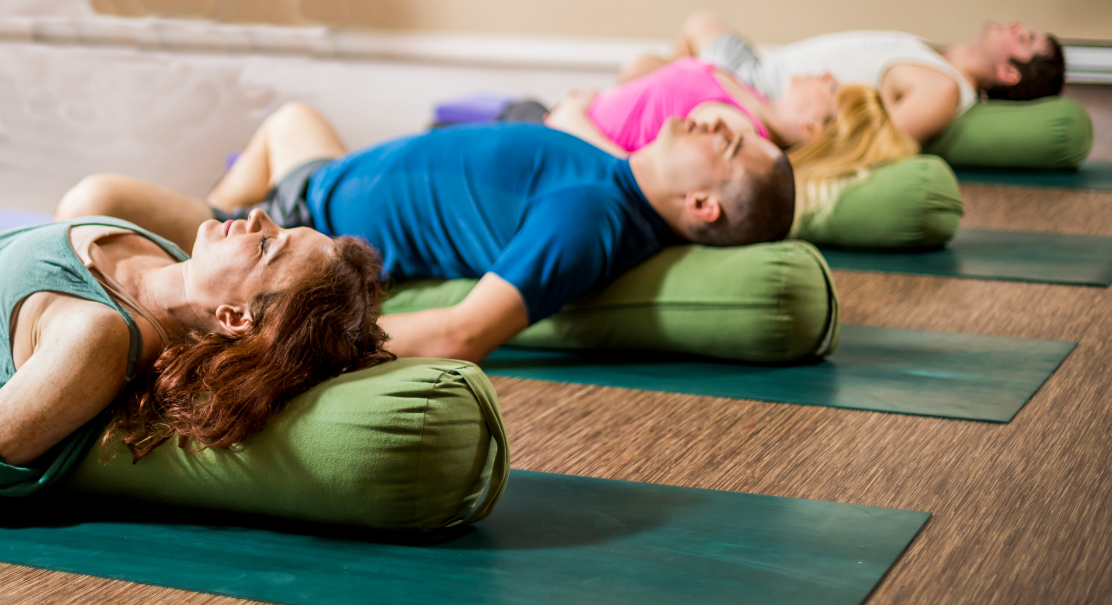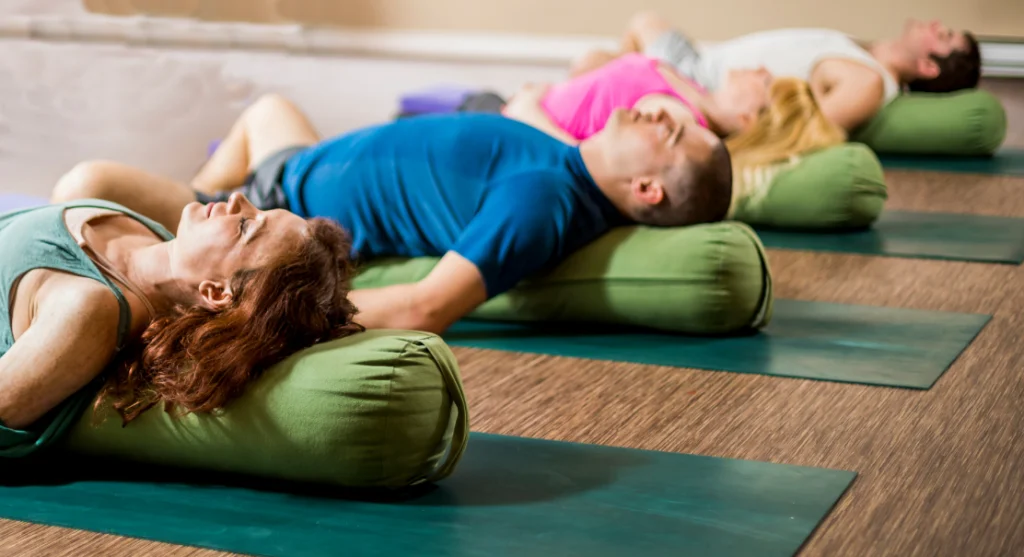
Creating Space with Yin Yoga: A Practice for Inner Stillness and Cleansing
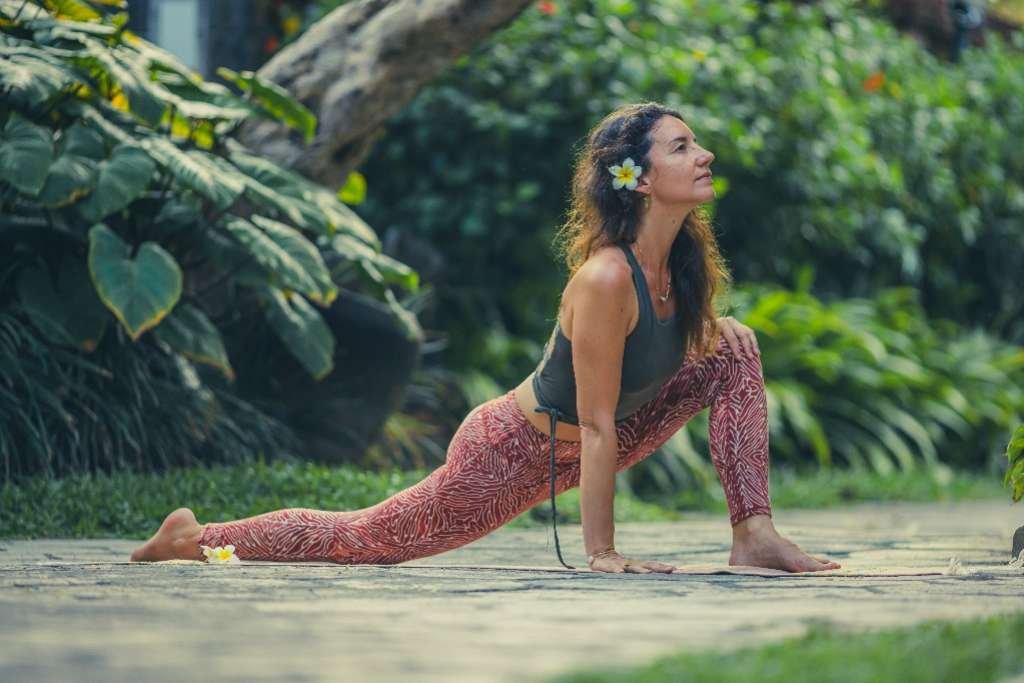
Four years ago, my acupuncturist told me something that stuck with me: there was no space in my life for change, growth, or anything new. At the time, I was juggling a corporate career, teaching yoga at night, and running a custom jewelry business on the side. Despite being deeply fulfilled in my work, I realized that I was filling every minute of my day to avoid facing what I was truly feeling.
When I finally decided to slow down and create space, it was one of the hardest things I had ever done. I left my corporate job to focus on my passions, and while I suddenly had more time, I also had more space to face emotions and feelings I had been avoiding for years. It was difficult and lonely at times, but that’s when my meditation practice began. As I learned to sit with stillness, I found that creating space in my life started from within.
Learning to be still was a profoundly cleansing process, much like the practice of Saucha in yoga. Saucha means “cleanliness” or “purity,” and it’s the first niyama (yogic rule of conduct) that applies to the individual. It’s not just about physical cleanliness, but also about cleansing the mind of negative thoughts, emotions, and clutter. This internal cleansing brings joy, radiance, and mental peace, and it requires patience and effort, much like cleaning a house properly.
The same goes for clearing out the emotional clutter in our lives. When we make space in our minds and hearts, we open ourselves up to new opportunities and experiences. This Yin Yoga practice is designed to help you explore this internal quieting and cleansing process. It focuses on stretching and creating space in the connective tissues, allowing you to work through discomfort, release tension, and restore fluidity in your body and mind.
Yin Yoga Sequence: A Practice to Create Space for Possibility
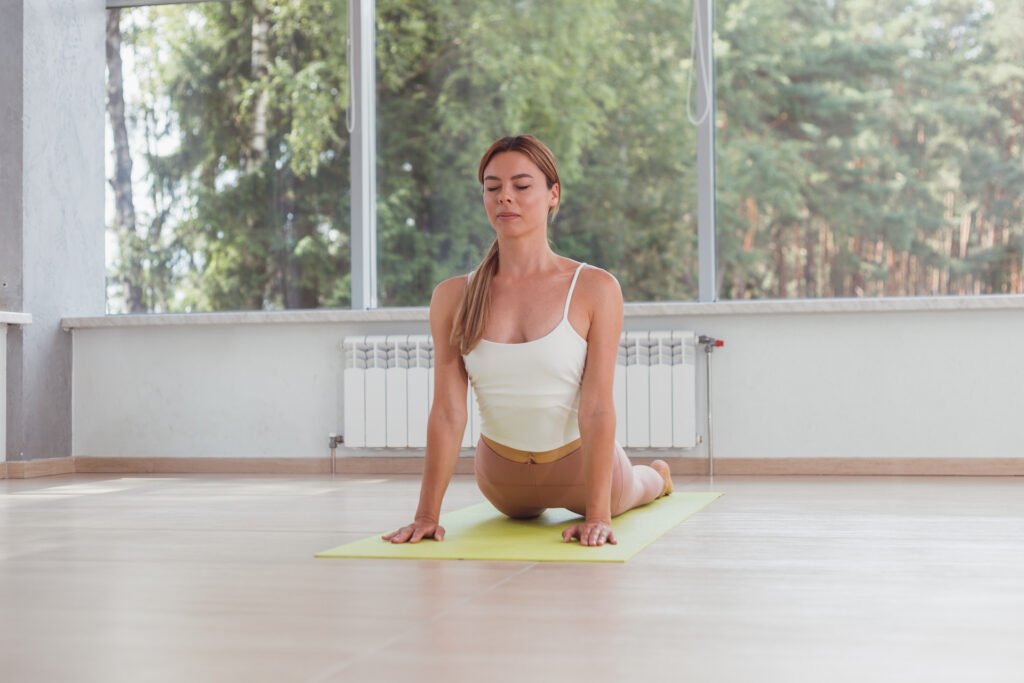
This sequence is slower-paced and utilizes body weight and gravity to create space in your connective tissues. The focus is on holding each shape long enough to invite a healthy level of discomfort—just enough to stimulate release. Over time, this practice will create spaciousness in your body and mind, allowing you to slow down and let go of what no longer serves you.
Note: This sequence is made up of twists and backbends, which tend to have an energetic and awakening component. It’s best suited for daytime practice. If you practice in the evening, consider adding forward bends afterward to help balance your energy.
Make sure to have a block or a folded blanket nearby to support your practice.
1. Seated Meditation
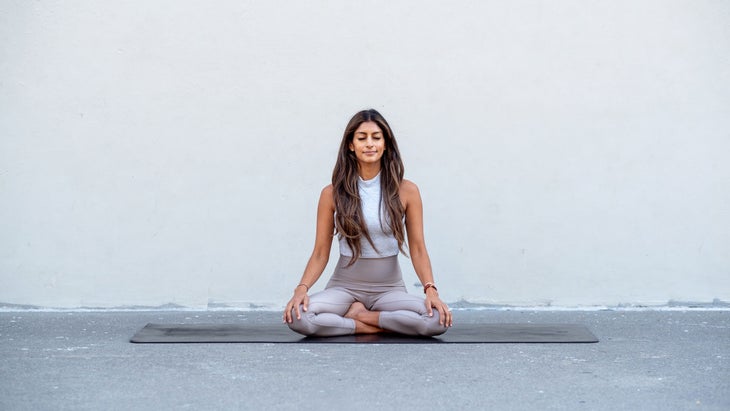
Sit comfortably, either cross-legged or on your heels in Vajrasana. Place a block underneath your seat to lengthen the base of your spine and reduce pressure on your knees. Sit tall and lower your chin slightly. Soften your gaze or close your eyes. As you settle into stillness, notice the chatter of your mind, which arises when we slow down. Bring your attention to your breath and observe the pattern of your inhales and exhales. Stay here for at least 5 minutes or longer.
2. Bananasana (Side Body Stretch)
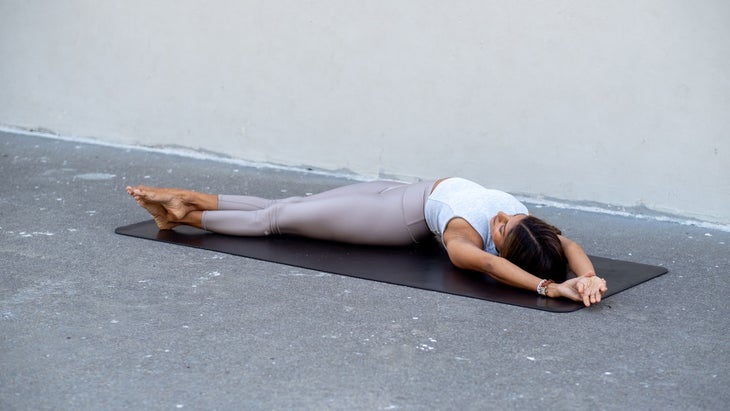
Lie on your back and bring your legs together, reaching your arms overhead. Take hold of your left hand with your right and guide your arms toward the upper right corner of your mat. Move your feet toward the right, and if it feels good, cross your left ankle over your right. Keep your hips grounded and feel the stretch along your left side body. Stay here for 3 to 5 minutes, then return to center and switch sides.
3. Reclined Supine Twist

From Bananasana, bring your knees toward your chest. Open your arms to the sides like wings, and gently drape your knees to the left while turning your head to the right. Place a block or blanket under your knees for support. The deeper you draw your legs toward your chest, the more the twist moves into your upper spine. If your right shoulder is lifting off the ground, place a blanket underneath it for support. Stay for 3 to 5 minutes, then switch sides.
4. Sphinx Pose
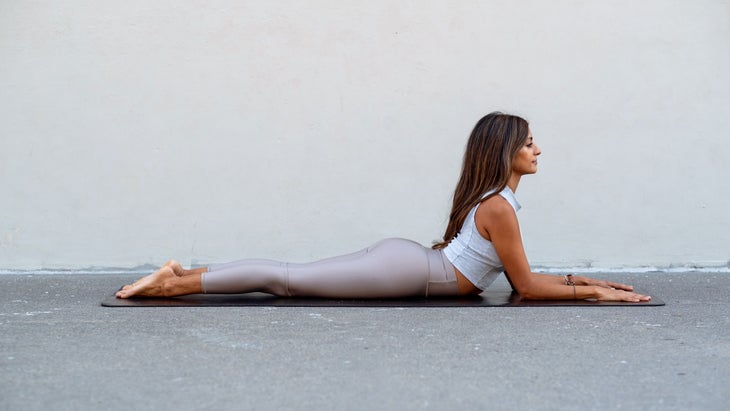
From lying on your back, roll over to your right side and pause briefly in the Fetus Position. Make your way onto your belly and bring your elbows just an inch in front of your shoulders. Align your forearms parallel to the long edges of the mat. If your lower back feels too intense, move your elbows forward and lower your chest toward the floor. Rest your forehead on a block or keep your head lifted. Stay in Sphinx Pose for 3 to 5 minutes, then gently lower your chest to the floor and roll to the other side.
5. Melting Heart Pose
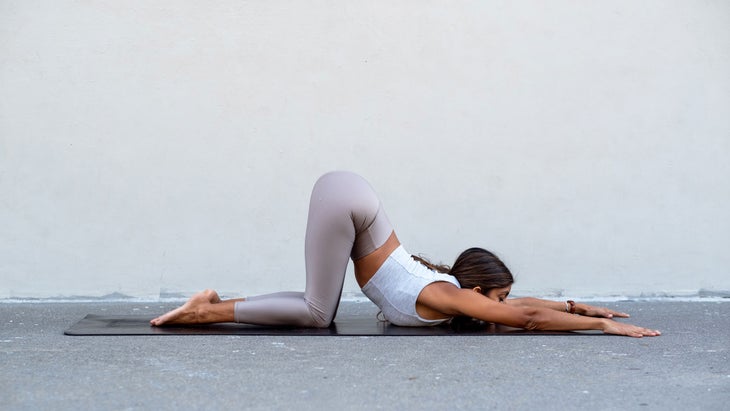
From hands and knees, align your hips over your knees and walk your hands forward. Lower your chest and forehead to the floor in Melting Heart Pose. You can use blocks under your chest and forehead for support. If your hands are slipping, hold onto the edge of your mat for resistance. Keep your forehead down, or if it feels comfortable, take your gaze forward. Stay in this shape for 3 to 5 minutes, breathing into the space you’re creating in your upper and middle back.
6. Saddle Pose
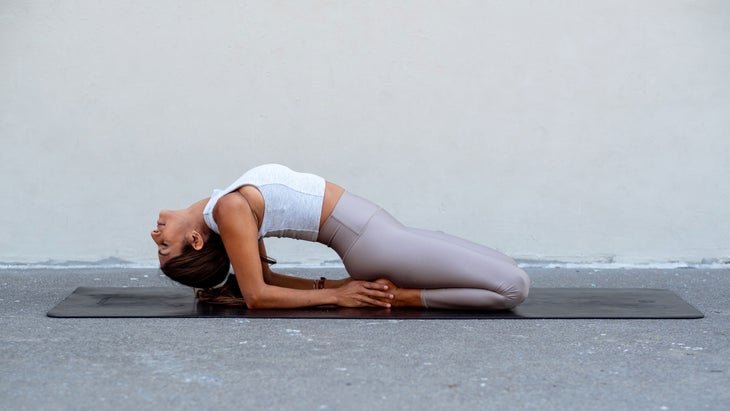
From hands and knees, sit on your heels and widen your knees slightly. If this is uncomfortable, place a blanket underneath you for added cushioning. Walk your hands back to create a small arch in your lower back. Assess whether this sensation is enough for you; Yin Yoga is about finding a place where you can hold a position for an extended period. For a deeper stretch, lower down onto your forearms. If comfortable, release your head back. Stay for 3 to 5 minutes, then slowly come out by pressing into your forearms and rising up.
7. Cat Pulling Its Tail
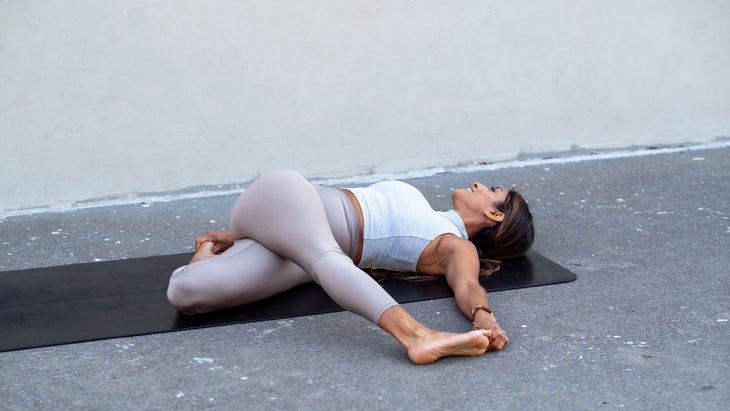
Lie down on your back and bend your right knee toward your chest, crossing it over your left leg. Bend your left leg, bringing your left heel toward your bum while keeping the left knee in line with your hip. Reach with your right hand to hold the outer edge of your left foot. If this feels too intense, a simple Supine Twist can also offer great relief. Hold this shape for 3 to 5 minutes, then gently release and switch sides.
8. Viparita Karani (Legs Up the Wall) Variation
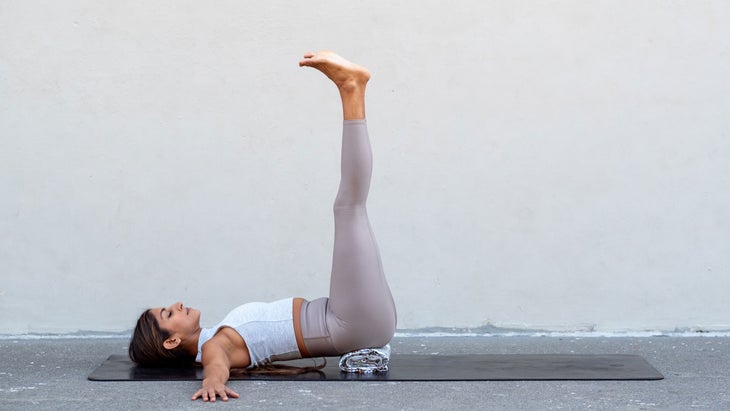
Lie on your back and bend your knees, lifting your hips slightly off the floor. Place a block or folded blanket underneath your sacrum for support. Straighten your legs and point your toes toward the sky. Let your arms rest beside you or above your head. Relax your fingers, jaw, and even the space between your eyebrows. Stay in this position for at least 5 minutes, focusing on the spaciousness and openness you’ve created. When you’re ready, slowly lower your feet and bring them back to the mat.
Conclusion: Cleansing Through Stillness
Creating space, both physically and emotionally, takes time and patience. This Yin Yoga sequence is designed to help you explore the practice of slowing down, cleansing, and creating space for possibility. As you hold each shape, notice your reactions to discomfort and how, over time, your body and mind start to open up. Just like cleaning out a cluttered home, creating space within yourself takes time—but once you do, you’ll find more room for growth, clarity, and new experiences. Embrace the stillness, breathe through the discomfort, and allow yourself to make space for something new.
